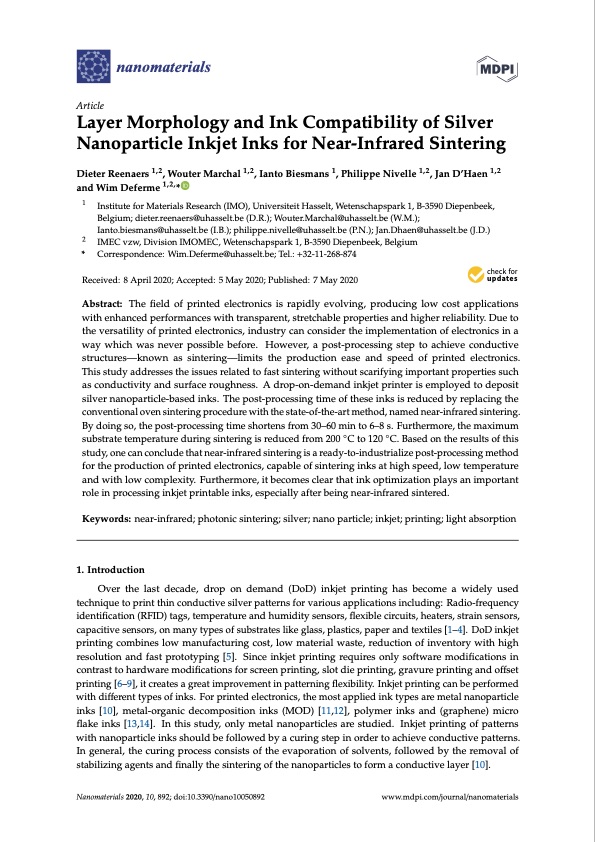
PDF Publication Title:
Text from PDF Page: 001
nanomaterials Article Layer Morphology and Ink Compatibility of Silver Nanoparticle Inkjet Inks for Near-Infrared Sintering Dieter Reenaers 1,2, Wouter Marchal 1,2, Ianto Biesmans 1, Philippe Nivelle 1,2, Jan D’Haen 1,2 and Wim Deferme 1,2,* 1 Institute for Materials Research (IMO), Universiteit Hasselt, Wetenschapspark 1, B-3590 Diepenbeek, Belgium; dieter.reenaers@uhasselt.be (D.R.); Wouter.Marchal@uhasselt.be (W.M.); Ianto.biesmans@uhasselt.be (I.B.); philippe.nivelle@uhasselt.be (P.N.); Jan.Dhaen@uhasselt.be (J.D.) IMEC vzw, Division IMOMEC, Wetenschapspark 1, B-3590 Diepenbeek, Belgium 2 * Correspondence: Wim.Deferme@uhasselt.be; Tel.: +32-11-268-874 Received: 8 April 2020; Accepted: 5 May 2020; Published: 7 May 2020 Abstract: The field of printed electronics is rapidly evolving, producing low cost applications with enhanced performances with transparent, stretchable properties and higher reliability. Due to the versatility of printed electronics, industry can consider the implementation of electronics in a way which was never possible before. However, a post-processing step to achieve conductive structures—known as sintering—limits the production ease and speed of printed electronics. This study addresses the issues related to fast sintering without scarifying important properties such as conductivity and surface roughness. A drop-on-demand inkjet printer is employed to deposit silver nanoparticle-based inks. The post-processing time of these inks is reduced by replacing the conventional oven sintering procedure with the state-of-the-art method, named near-infrared sintering. By doing so, the post-processing time shortens from 30–60 min to 6–8 s. Furthermore, the maximum substrate temperature during sintering is reduced from 200 ◦C to 120 ◦C. Based on the results of this study, one can conclude that near-infrared sintering is a ready-to-industrialize post-processing method for the production of printed electronics, capable of sintering inks at high speed, low temperature and with low complexity. Furthermore, it becomes clear that ink optimization plays an important role in processing inkjet printable inks, especially after being near-infrared sintered. Keywords: near-infrared; photonic sintering; silver; nano particle; inkjet; printing; light absorption 1. Introduction Over the last decade, drop on demand (DoD) inkjet printing has become a widely used technique to print thin conductive silver patterns for various applications including: Radio-frequency identification (RFID) tags, temperature and humidity sensors, flexible circuits, heaters, strain sensors, capacitive sensors, on many types of substrates like glass, plastics, paper and textiles [1–4]. DoD inkjet printing combines low manufacturing cost, low material waste, reduction of inventory with high resolution and fast prototyping [5]. Since inkjet printing requires only software modifications in contrast to hardware modifications for screen printing, slot die printing, gravure printing and offset printing [6–9], it creates a great improvement in patterning flexibility. Inkjet printing can be performed with different types of inks. For printed electronics, the most applied ink types are metal nanoparticle inks [10], metal-organic decomposition inks (MOD) [11,12], polymer inks and (graphene) micro flake inks [13,14]. In this study, only metal nanoparticles are studied. Inkjet printing of patterns with nanoparticle inks should be followed by a curing step in order to achieve conductive patterns. In general, the curing process consists of the evaporation of solvents, followed by the removal of stabilizing agents and finally the sintering of the nanoparticles to form a conductive layer [10]. Nanomaterials 2020, 10, 892; doi:10.3390/nano10050892 www.mdpi.com/journal/nanomaterialsPDF Image | Nanoparticle Inkjet Inks for Near-Infrared Sintering

PDF Search Title:
Nanoparticle Inkjet Inks for Near-Infrared SinteringOriginal File Name Searched:
nanomaterials-10-00892.pdfDIY PDF Search: Google It | Yahoo | Bing
Turbine and System Plans CAD CAM: Special for this month, any plans are $10,000 for complete Cad/Cam blueprints. License is for one build. Try before you buy a production license. More Info
Waste Heat Power Technology: Organic Rankine Cycle uses waste heat to make electricity, shaft horsepower and cooling. More Info
All Turbine and System Products: Infinity Turbine ORD systems, turbine generator sets, build plans and more to use your waste heat from 30C to 100C. More Info
CO2 Phase Change Demonstrator: CO2 goes supercritical at 30 C. This is a experimental platform which you can use to demonstrate phase change with low heat. Includes integration area for small CO2 turbine, static generator, and more. This can also be used for a GTL Gas to Liquids experimental platform. More Info
Introducing the Infinity Turbine Products Infinity Turbine develops and builds systems for making power from waste heat. It also is working on innovative strategies for storing, making, and deploying energy. More Info
Need Strategy? Use our Consulting and analyst services Infinity Turbine LLC is pleased to announce its consulting and analyst services. We have worked in the renewable energy industry as a researcher, developing sales and markets, along with may inventions and innovations. More Info
Made in USA with Global Energy Millennial Web Engine These pages were made with the Global Energy Web PDF Engine using Filemaker (Claris) software.
Infinity Turbine Developing Spinning Disc Reactor SDR or Spinning Disc Reactors reduce processing time for liquid production of Silver Nanoparticles.
| CONTACT TEL: 608-238-6001 Email: greg@infinityturbine.com | RSS | AMP |